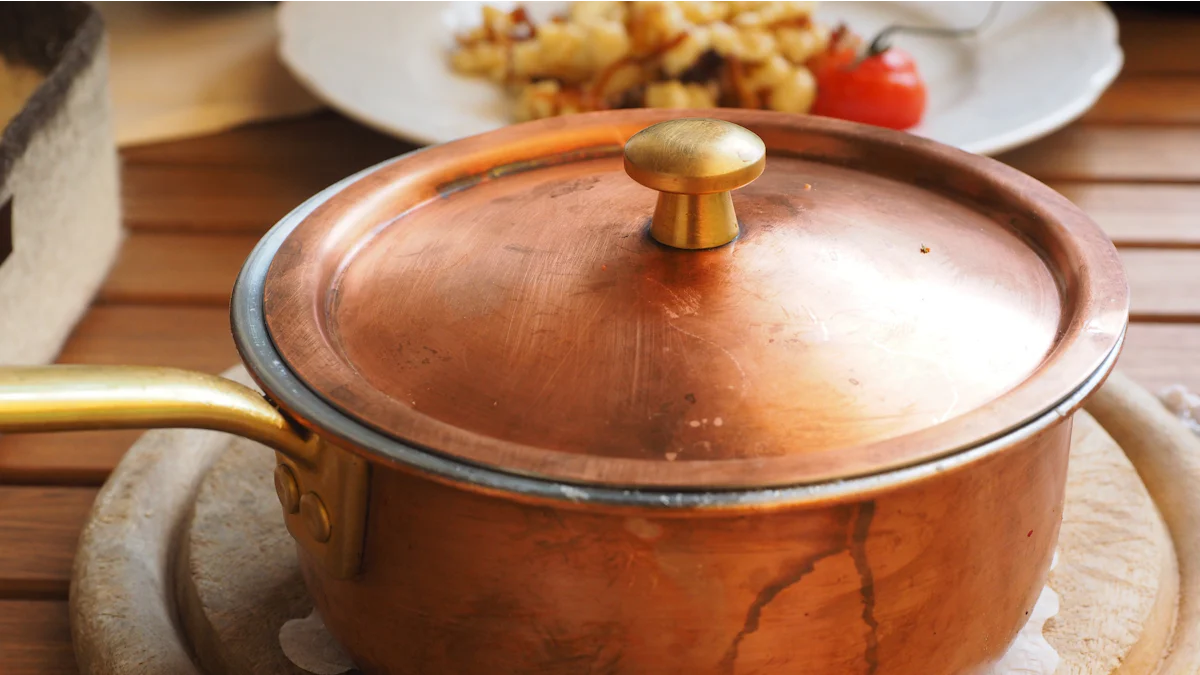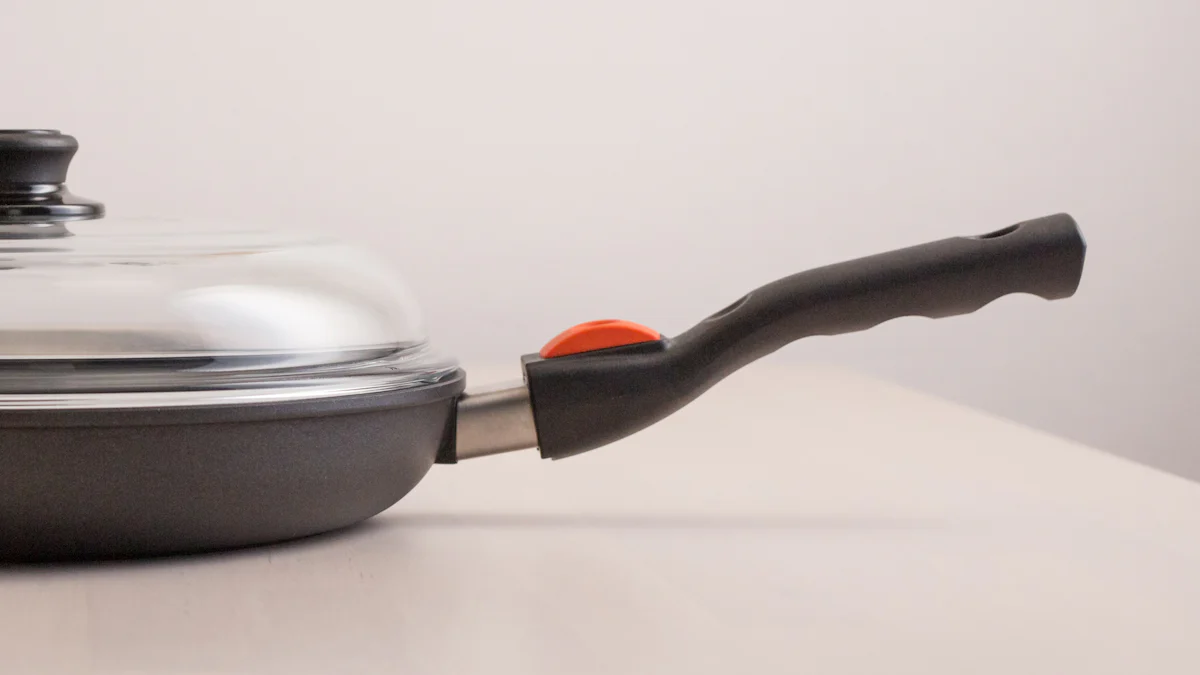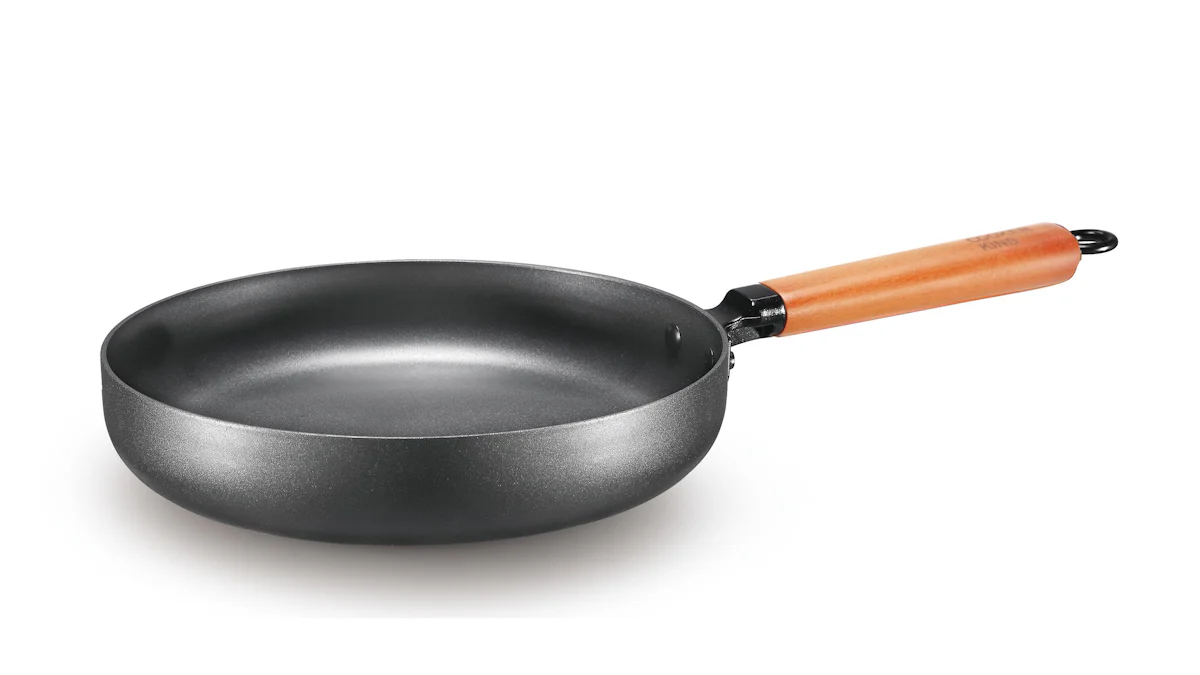
Cookware handle materials play a crucial role in enhancing the cooking experience. They must withstand heat, provide comfort, and ensure durability. Silicone, stainless steel, wood, and rubber offer unique advantages for different needs. Choosing the right material depends on factors like safety, ease of use, and maintenance preferences. Each option caters to specific cooking styles.
Key Takeaways
- Silicone handles resist heat and stay cool, making them safe.
- Stainless steel handles are strong and stylish, great for hot cooking.
- Wooden and rubber handles feel comfy and don’t slip, adding safety.
Heat-Resistant Cookware Handle Materials

Silicone Handles
Silicone handles are a popular choice for cookware due to their exceptional heat resistance. They can withstand temperatures up to 500°F, making them ideal for stovetop and oven use. Silicone remains cool to the touch during cooking, reducing the risk of burns. Its soft texture provides a comfortable grip, enhancing safety and usability. Additionally, silicone handles are non-slip, ensuring a firm hold even when hands are wet or greasy. These handles are also easy to clean and maintain, as they resist stains and odors. For cooks seeking a versatile and safe option, silicone proves to be a reliable material for cookware handles.
Stainless Steel Handles
Stainless steel handles are known for their durability and sleek appearance. They excel in high-heat environments, making them suitable for both stovetop and oven use. Unlike other materials, stainless steel does not warp or degrade over time, ensuring long-lasting performance. Its smooth surface provides a firm grip, though some designs may include ergonomic features for added comfort. Stainless steel handles are often riveted to cookware, offering superior stability. While they may become hot during extended cooking, their heat resistance and durability make them a preferred choice for professional chefs and home cooks alike.
Phenolic Resin Handles
Phenolic resin handles combine heat resistance with lightweight construction. This material can endure temperatures up to 350°F, making it suitable for most stovetop applications. Phenolic resin remains cool to the touch, providing a safe and comfortable cooking experience. Its durability ensures resistance to cracking, chipping, and discoloration, even with frequent use. These handles are often found on budget-friendly cookware, offering an affordable yet reliable option. For those prioritizing safety and ease of use, phenolic resin handles deliver excellent performance without compromising quality.
Comfortable and Ergonomic Cookware Handle Materials

Wooden Handles
Wooden handles offer a classic and natural feel, making them a favorite among traditional cooks. These handles remain cool to the touch, even during prolonged cooking sessions. Their ergonomic design ensures a comfortable grip, reducing hand fatigue during use. Wood also provides a non-slip surface, enhancing safety in the kitchen. Many high-quality wooden handles are treated with heat-resistant finishes, which protect the material from damage and extend its lifespan. However, they require proper care to maintain their appearance and functionality. Wooden handles add a touch of elegance to cookware, making them a stylish yet practical choice for any kitchen.
Rubber-Coated Handles
Rubber-coated handles prioritize comfort and safety. The soft, textured surface provides a secure grip, even when hands are wet or greasy. This feature makes them ideal for busy kitchens where quick handling is essential. Rubber coatings also offer excellent heat resistance, ensuring the handle remains cool during cooking. Many rubber-coated designs incorporate ergonomic shapes, which fit naturally in the hand for added ease of use. These handles are easy to clean and maintain, making them a practical option for everyday cooking. Their combination of functionality and comfort makes rubber-coated handles a reliable choice for modern cookware.
Soft-Touch Plastic Handles
Soft-touch plastic handles combine lightweight construction with a comfortable grip. The smooth yet slightly textured surface ensures a firm hold, minimizing the risk of slipping. These handles often feature ergonomic designs, which enhance usability and reduce strain during extended cooking sessions. Soft-touch plastic materials are heat-resistant, making them suitable for stovetop use. They are also highly durable, resisting wear and tear over time. Many cookware manufacturers use soft-touch plastic handles to create a balance between affordability and performance. For cooks seeking a lightweight and user-friendly option, these handles deliver excellent results.
Durable and Long-Lasting Cookware Handle Materials
Stainless Steel Handles
Stainless steel handles stand out for their unmatched durability and timeless design. This material resists rust, corrosion, and wear, making it a reliable choice for long-term use. Its robust structure ensures it can handle heavy cookware without bending or breaking. Many stainless steel handles feature a polished finish, which enhances their aesthetic appeal while simplifying cleaning. These handles often come riveted to the cookware, providing superior stability during use. Their ability to withstand high temperatures makes them suitable for stovetop and oven cooking. For those seeking a combination of strength and elegance, stainless steel handles deliver exceptional performance.
Cast Iron Handles
Cast iron handles are synonymous with durability and strength. These handles are crafted from the same material as the cookware, ensuring seamless integration and consistent performance. Cast iron retains heat exceptionally well, making it ideal for high-heat cooking methods like searing and frying. While these handles can become hot during use, their rugged construction ensures they last for decades with proper care. Many cast iron cookware pieces feature helper handles, which provide additional support when lifting heavy pots or pans. For cooks who value longevity and reliability, cast iron handles are an excellent choice.
Hard-Anodized Aluminum Handles
Hard-anodized aluminum handles combine lightweight construction with impressive durability. The anodization process creates a tough, non-reactive surface that resists scratches, corrosion, and wear. These handles are often designed with ergonomic features, ensuring a comfortable grip during extended cooking sessions. Hard-anodized aluminum handles can endure high temperatures, making them suitable for various cooking techniques. Their sleek appearance complements modern cookware designs, adding a touch of sophistication to the kitchen. For those prioritizing durability without sacrificing style, hard-anodized aluminum handles offer a practical solution.
Cookware Handle Materials for Specific Cooking Needs
Oven-Safe Handles
Oven-safe handles are essential for cookware used in baking or roasting. These handles are crafted from materials that can endure high oven temperatures without warping or melting. Stainless steel and cast iron are common choices due to their exceptional heat tolerance. Silicone-wrapped handles also perform well in ovens, offering a cool-touch surface when transferring cookware. Manufacturers often label cookware with oven-safe temperature limits, ensuring users can safely transition from stovetop to oven. For those who frequently bake or roast, selecting cookware with oven-safe handles ensures versatility and safety during cooking.
Non-Slip Handles
Non-slip handles enhance safety by providing a secure grip, even in challenging conditions. Rubber-coated and silicone handles excel in this category, as their textured surfaces prevent slipping when hands are wet or greasy. Wooden handles also offer natural non-slip properties, making them a reliable option for cooks seeking a traditional aesthetic. Many non-slip designs incorporate ergonomic features, ensuring comfort during extended use. These handles are particularly beneficial in busy kitchens where quick and safe handling is crucial. For cooks prioritizing safety, non-slip handles deliver peace of mind and ease of use.
Handles for High-Heat Cooking
Handles designed for high-heat cooking must withstand extreme temperatures without compromising performance. Cast iron and stainless steel handles are ideal for searing, frying, or broiling, as they resist heat damage and maintain structural integrity. Hard-anodized aluminum handles also perform well under high heat, offering durability and lightweight construction. These handles often feature riveted attachments, ensuring stability during intense cooking sessions. For chefs who frequently use high-heat techniques, investing in cookware with heat-resistant handles ensures reliability and longevity.
Selecting the right cookware handle material depends on individual priorities. Silicone and stainless steel excel in heat resistance, making them ideal for high-temperature cooking. Wood and rubber prioritize comfort, offering ergonomic and non-slip designs. For durability, stainless steel and cast iron stand out. Evaluating cooking habits and preferences ensures the best choice for every kitchen.
FAQ
What is the most heat-resistant cookware handle material?
Stainless steel and silicone handles excel in heat resistance. Stainless steel withstands extreme temperatures, while silicone remains cool to the touch during stovetop and oven use.
Which handle material is best for comfort and grip?
Rubber-coated and wooden handles provide excellent comfort. Rubber offers a soft, non-slip grip, while wood ensures ergonomic support and a natural feel during cooking.
Are all cookware handles oven-safe?
No, not all handles are oven-safe. Stainless steel, cast iron, and silicone-wrapped handles are suitable for ovens. Always check the manufacturer’s specifications for temperature limits.
Post time: Jan-26-2025
